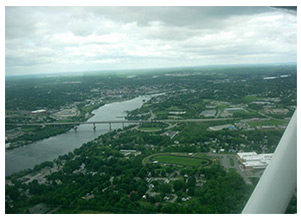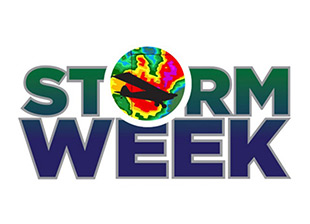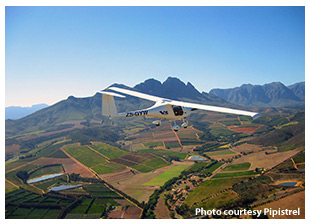Training Tips
|

The lingering low
The low overcast ceiling, fog, and rain associated with yesterday's frontal passage are gone as a new day dawns. But a lively surface wind still blows, and broken cloud layers fill the sky as high pressure slowly works its way back into the area.
The morning's terminal aerodrome forecast calls for that gusty northwest wind to abate by afternoon. The current surface observation makes clear that a morning training flight to practice takeoffs and landings will be beneficial: 151453Z 34014G24KT 10SM BKN030 BKN047 21/11 A2988.
Those winds reported at the point of departure would seem to favor Runway 30, not Runway 04-22, at the two-runway destination airport 10 miles away. Even a short trip can mean big changes in surface winds, so it will be wise to verify that hunch. Since the outlying airport has no on-field weather reporting, and is often unattended, the pilots will have to ascertain surface winds the old-fashioned way—by overflying the airport above traffic pattern altitude and checking the wind indicator.
Strong winds don't always imply turbulence. However, an informed pilot glancing at the sky on this post-frontal morning will expect it to be present.
The tipoff? The flattened appearance of the bases of the broken clouds at 3,000 feet: "They're caused by the shearing forces of strong, low-level winds," wrote Thomas A. Horne in "Wx Watch: Eyes Wide Open."
"Below the bases, you'll be in the bumps, but if you can safely climb to on-top conditions a smooth ride awaits," he wrote.
Climbing above the deck wouldn't be practical on today's short hop. So add experiencing a short cruise leg under conditions of moderate turbulence to the day’s practice agenda.
And it turns out on arrival at the outlying airport—which is slightly closer to the lazily departing low—that the surface wind blows with a more northerly component, promising a lively, variable crosswind regardless of the runway that is chosen for landing. (As the pilots will learn later, the low's reticence to depart the area has generated an amended TAF, extending the duration of 15-knot winds gusting to 25 knots through midnight Zulu.)
How do you like your crosswind—left or right? Conditions like this, and the availability of a multiple-runway airport, create an opportunity to practice both.
Include a go-around or two for practice and to maintain a strong safety margin if your approach becomes unstable down there in the bumps!
|
|
|
|
Flight Training News
|
|
Article
A trilingual pilot from Colorado who recently became a flight instructor will soon travel to France to fly in the Tour Aérien Des Jeunes Pilotes.
Read more...
 
KSU aviation program creates jet engine sim curriculum
The aviation program at Kansas State University Salina will work with France's Price Induction to develop curriculum for a jet engine simulator. The university will use the company's new virtual engine test bench that simulates the DGEN 380 lightweight gas turbine engine. The engine will be available for a year, during which the university will generate an education model that could be used in other academic settings.
PDF
According to a new study by the Air Safety Institute, the fatal accident rate during flight instruction was less than half that on noninstructional flights—no matter whether you're learning to fly airplanes or helicopters. So Mom can relax (at least halfway). To see which training activities are safer than you'd expect and which merit a little extra caution,
read the full report.
Pacific Air Museum offers summer youth programs
Hawaii's Pacific Air Museum Pearl Harbor is offering two aviation summer programs for youths. Flight School, for sixth to eighth graders, will offer immersive activities with an emphasis on Pacific aviation. Aviation Adventure, for youths aged 13 and up, will teach the history of aviation in Hawaii, along with the science, technology, engineering, and math principles of flight.

Storm Week
With the convective season in full swing in most parts of the United States, the Air Safety Institute held its annual Storm Week at the beginning of June. If you missed it, here's your opportunity to visit the highlights of the week, including a new "Flying the Weather" safety video, thunderstorm safety quiz, and recorded version of the new "Datalink: Cockpit Weather Do's and Don'ts" webinar.
Learn more...
 
Apps of the week
Five apps range from a timer to a wind component calculator.
Read more...
 
|
Training Resources
|
|
Login required
The Pilot/Controller Glossary was developed to help promote a common understanding of the terms used in the air traffic control system. Are you and ATC on the same page? Find out by taking this Air Safety Institute quiz.
Take the quiz...
|
|
Did you know that student pilots who join AOPA are three times more likely to complete their flight training? Membership includes unlimited access to aviation information by phone (800/USA-AOPA, weekdays from 8:30 a.m. to 8 p.m. Eastern time) or from Flight Training Online or AOPA Online. If you're not already a member, join today and get the pilot's edge.
|
|
|
AOPA Live
|
|
AOPA Live This Week
AOPA President Mark Baker testified before the House Aviation Subcommittee June 18 about the importance of Aircraft Improvement Program funding. Plus, take part in a special mission: flying athletes to compete in the 2014 Special Olympics USA Games in New Jersey. And, get a look at the AOPA Sweepstakes Debonair's new makeover.
AOPA Live This Week®, June 19...
 
|
|
Career Pilot
|
Bombardier signs CRJ sim deal with CAE
Bombardier Aerospace has named Montreal-based CAE as its authorized training provider for the manufacturer's CRJ family of regional aircraft. Under the deal, CAE instructors will offer flight training courses at locations around the world.
Low-cost carriers, joint ventures to increase competition
PricewaterhouseCoopers on June 3 released Tailwinds, its annual report on the airline industry, which says that the global airline industry is set to face more aggressive competition in the coming year. This competition is being boosted by expansion of the low-cost carrier business model, the rapid growth of airlines in the Middle East, and a rise in joint ventures to increase international flights. Driving efficiencies by becoming a "connected airline" can help airlines better navigate the landscape and stay ahead, the report said. Low-cost carriers continued to gain global market share, increasing to more than 25 percent in 2013 and restraining the yields of legacy carriers.
|
|
For more aviation career news, see the Flight Training website.
|
|
|
Plane Spotter
|

'Touring motorglider'
Whether sporting the distinctively high-aspect-ratio wings of motorgliders or the slender, tapered tail cones of aircraft built using honeycombed construction methods—or both—advanced light aircraft are a plane-spotting specialty certain to grow in importance and visibility around many airports. Slovenian manufacturer Pipistrel knows the territory well, as reflected in a product line featuring models such as the Virus 912, designed for training and cross-country flying. Another virtue, says the manufacturer, is its low noise level—even when the 80-horsepower Rotax engine of this T-tailed "touring motorglider" is running.
|
Training Products
|
Aircraft Spruce joins Redbird distribution network
AOPA Strategic Partner Aircraft Spruce is offering the complete line of Redbird flight simulators. Products available include everything from the Jay desktop simulator to the Redbird MCX full-motion sim.
ASA releases managing risk book
Managing Risk: Best Practices for Pilots is now available from ASA. The book uses actual aircraft accident examples, statistics, aviation safety studies, and the authors' more than 60 years of combined experience as pilots and flight safety educators to document and describe the 10 most significant accident threat categories, and shed light on the applicable human-factor issues that make pilots vulnerable to them. The book is available in soft cover or e-book formats.
|
|
Note: Products listed have not been evaluated by ePilot editors unless otherwise noted. AOPA assumes no responsibility for products or services listed or for claims or actions by manufacturers or vendors.
|
Member Benefits
|
|
Member benefits
Texas recently increased the speed limit on some stretches of interstate highway to 85 mph. Other states have increased speed limits to 75 mph. The higher the rate of speed you're traveling, the less time you have to react to anything happening around you. Consider these rules for the road, brought to you by AOPA Emergency Assistance Plus, before your next trip.
Read more...
 
Members only
Is a high-stress lifestyle turning your hair gray? Maybe not.
Read more...
 
|
|
|
Blogs
|
|
Starting with the Boeing B-17, pilots have been conditioned to use a written checklist for nearly every phase of flight. And why not? We make grocery lists to keep from forgetting something.
Read more...
 
What can we learn by applying a baseball fan's enthusiasm for statistics to aviation? A good estimate of how much flight training will cost, for starters.
Read more...
 
|
|
|
Instrument Tip
|
|
IFR Fix
Quiz: After a pilot decreases his airspeed in a standard-rate turn, is more or less bank needed to maintain the turn?
Read more...
 
|
Final Exam
|
Question
What types of activities are conducted in military operations areas (MOAs) that can make them dangerous to transient aircraft?
Answer
Operations within an MOA can include air-combat, low-altitude, and high-speed tactics; intercepts; and formation flight. Military aircraft within an active MOA are exempt from several Part 91 regulations and are permitted to conduct these activities within Class D and E surface areas, as well as operate in excess of 250 knots below 10,000 feet. See Aeronautical Information Manual 3-4-5.
|
|
Got a question for our technical services staff? Contact AOPA.
|
|
|
Career Opportunities
|
|
Aviation job board
Help others realize the dream of owning their own aircraft as an aircraft finance analyst at AOPA. The ideal candidate will be a detail-oriented team player with excellent people, phone, and multitasking skills. A strong interest in finance and a background in general aviation is essential.
Learn more or apply today.
AOPA career opportunities
Ever dream of turning your passion for aviation into a career? We're looking for an aviation technical specialist, Air Safety Institute intern, aircraft finance analyst I, member services representative, major gift officer, AOPA Live producer/videographer I, and account manager II. To learn more about other AOPA career opportunities,
visit AOPA Online.
|
 |
Education and Seminars
|
Flight Instructor Refresher Courses
June 21-22 - Charlotte, N.C.; Minneapolis, Minn.; and Orlando, Fla.
June 28-29 - Columbus, Ohio; and Phoenix, Ariz.
July 12-13 - Memphis, Tenn.; and Pittsburgh, Pa.
July 19-20 - Jacksonville, Fla.; and Newark, N.J.
For a complete schedule, see AOPA Online. Can't make it in person? Sign up for the Air Safety Institute's new Online eFIRC.
|
Air Safety Institute Safety Seminars
June 21 - Loveland, Colo.
June 28 - Groton, Conn.
July 31-Aug 2 - Oshkosh, Wis.
Topics vary—for details and a complete schedule, see AOPA Online.
|
Rusty Pilot Seminars
June 20 - Lititz, Pa.
June 21 - Romeoville, Ill.; and San Jose, Calif.
June 28 - Carson City, Nev.; and West Bend, Wis.
For a complete schedule, see AOPA Online.
|
|
|
|
Aviation Calendar
|
|
Want something to do this weekend? Planning an aviation getaway? See AOPA's enhanced calendar of events. Now you can filter events by date range, airport ID, state, or region. Before you take off on an adventure, make sure you check our current aviation weather provided by Jeppesen.
To include an event or to search all events in the calendar, visit AOPA Online. For airport details, including FBO fuel prices, see AOPA Airports.
AOPA Featured Events
Jul 12 — Plymouth, Massachusetts. Plymouth Airport (KPYM). AOPA Fly-In.
Aug 16 — Spokane, Washington. Spokane Felts Field (KSFF). AOPA Fly-In.
Sep 20 — Chino, California. Chino Airport (KCNO). AOPA Fly-In.
Oct 4 — Frederick, Maryland. Frederick Municipal Airport (KFDK). AOPA Homecoming.
Nov 8 — Brunswick, Georgia. Malcom McKinnon Airport (KSSI). AOPA Fly-In.
|
|
|
|
|
|
 |
|
|
ePilot Flight Training Editor:
Benét Wilson
Production Assistant:
Melissa Whitehouse |
Contributors:
Sarah Deener
Alyssa Miller
Jim Moore
Jill W. Tallman
Warren Morningstar
Alton K. Marsh
Dave Hirschman
Tom Horne
Ian J. Twombly
Dan Namowitz |
|
|
|
|